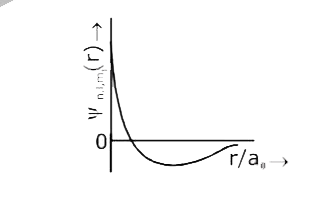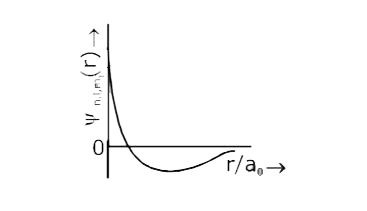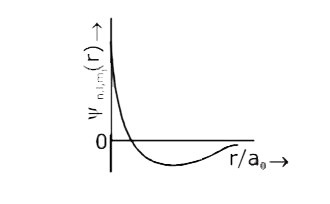Which of the given pairs of atoms contain(s) the same number of neutrons ?
I.
II. and
III.
IV.
I and IV only
I and III only
III only
IV only
The correct Answer is:C
To determine which pairs of atoms contain the same number of neutrons, we need to use the formula:
Number of Neutrons = Mass Number - Atomic Number
Let's analyze each pair one by one.
Step 1: Analyze Pair I - 11448Cdand11950Sn
1. For Cadmium (Cd):
- Mass Number = 114
- Atomic Number = 48
- Neutrons = 114 - 48 = 66
2. For Tin (Sn):
- Mass Number = 119
- Atomic Number = 50
- Neutrons = 119 - 50 = 69
Conclusion for Pair I: Cadmium has 66 neutrons, and Tin has 69 neutrons. Not the same.
Step 2: Analyze Pair II - 5927Coand5928Ni
1. For Cobalt (Co):
- Mass Number = 59
- Atomic Number = 27
- Neutrons = 59 - 27 = 32
2. For Nickel (Ni):
- Mass Number = 59
- Atomic Number = 28
- Neutrons = 59 - 28 = 31
Conclusion for Pair II: Cobalt has 32 neutrons, and Nickel has 31 neutrons. Not the same.
Step 3: Analyze Pair III - 13355Csand13254Xe
1. For Cesium (Cs):
- Mass Number = 133
- Atomic Number = 55
- Neutrons = 133 - 55 = 78
2. For Xenon (Xe):
- Mass Number = 132
- Atomic Number = 54
- Neutrons = 132 - 54 = 78
Conclusion for Pair III: Cesium has 78 neutrons, and Xenon also has 78 neutrons. They are the same.
Step 4: Analyze Pair IV - 6329Cuand6529Cu
1. For Copper (Cu) (first isotope):
- Mass Number = 63
- Atomic Number = 29
- Neutrons = 63 - 29 = 34
2. For Copper (Cu) (second isotope):
- Mass Number = 65
- Atomic Number = 29
- Neutrons = 65 - 29 = 36
Conclusion for Pair IV: Both isotopes of Copper have different numbers of neutrons (34 and 36). Not the same.
Final Conclusion:
The only pair that contains the same number of neutrons is Pair III: 13355Csand13254Xe.
- Mass Number = 114
- Atomic Number = 48
- Neutrons = 114 - 48 = 66
- Mass Number = 119
- Atomic Number = 50
- Neutrons = 119 - 50 = 69
- Mass Number = 59
- Atomic Number = 27
- Neutrons = 59 - 27 = 32
- Mass Number = 59
- Atomic Number = 28
- Neutrons = 59 - 28 = 31
- Mass Number = 133
- Atomic Number = 55
- Neutrons = 133 - 55 = 78
- Mass Number = 132
- Atomic Number = 54
- Neutrons = 132 - 54 = 78
- Mass Number = 63
- Atomic Number = 29
- Neutrons = 63 - 29 = 34
- Mass Number = 65
- Atomic Number = 29
- Neutrons = 65 - 29 = 36
The only pair that contains the same number of neutrons is Pair III: 13355Csand13254Xe.
Topper's Solved these Questions
Similar Questions
Complete the following :
i..7N14+.2He4→.8O17+……….
ii. .92U235+.0n1→.55A142+.37B92+……….
iii. .29Cu53→.28Ni53+………………
iv. 2.1H3→.2He4+.....
v. .96Cm246+.6C12→.102No254+...........
vi. .94Pu239+.......→.96Cm242+.0n1
vii. .34Se82→............+2.−1e0View SolutionSuppose the cube x3px+q has three distinct real roots where p>0 and q>0 . Then which one of the following holds? (1) The cubic has minima at (2)(3)√(4)(5)(6)p73(8)(9)(10)(11)(12) (13) and maxima at (14)(15)−√(16)(17)(18)p193(20)(21)(22)(23)(24) (26) The cubic has minima at (27)(28)−√(29)(30)(31)p323(33)(34)(35)(36)(37) (38) and maxima at (39)(40)√(41)(42)(43)p443(45)(46)(47)(48)(49) (51) The cubic has minima at both (52)(53)√(54)(55)(56)p573(58)(59)(60)(61)(62) (63) and (64)(65)−√(66)(67)(68)p693(70)(71)(72)(73)(74) (76) The cubic has maxima at both (77)(78)√(79)(80)(81)p823(83)(84)(85)(86)(87) (88) and (89)(90)−√(91)(92)(93)p943(95)(96)(97)(98)(99) (100)
View Solution
Knowledge Check
- Question 1 - Select One
Atomic number of Mn,FeCOandNi are 25,26,27 and 28 respectively . Which of the following outer orbital octahedral complexes have same number of unpaired electrons ?
I.[MnCl6]3− II.[FeF6]3−
III.[CoF6]3− IV.[Ni(NH3)6]2+ltbrlt choose the correct code .AIandIIBIIandIVCI,IIIandIVDIandIII - Question 2 - Select One
In which of the following paris both the ions are coloured in aqueous solution? (Atomic number, Sc−21,Ti=22,Ni=28,Cu=29,Co=27)
ANi2+ and Cu+BSc3+ and Ti3+CSc3+ and Co2+DNi2+ and Ti3+ - Question 3 - Select One
Wave function ψn,lm1 is a mathematical function, which vlaue depends on spherical polar coordinates (r,θ,ϕ) and titrated from quantum numbers n,landm1. Here, r is distance from nucleus, θ is Colatitude and ϕis azimuth. In mathematical functions which are given below table, Z is atomic number and a0 is Bohr Radius.
Column 1
(I) 1s Orbital
(II) 2s Orbital
(III)2pz Orbital
(IV) 3d2z Orbital
Column 2
(i) ψn,l,m1∝(za0)3zezra0
(ii) a radial node
(iii) ψn,l,m1∝(Za0)5ze(2r)re(2r2a0)cosθ
(iv) xy-plane is node
Column 3

(Q) nucleus per probability density ∝1a30
(R) nucleus per probability density is maximum
(S) energy requires to excited a electron from level n=2 to n=4,is2732 times
to energy requires to excited a electron from level n=2 to n=6
Which of the following options has correct combination for hydrogen atom ?A(I)(i)(P)B(I)(iv)(R)C(II)(I)(Q)D(I)(i)(S)
Find the number of reaction from the given reaction which can show calcination process :
(i) CaCO3.MgCO3Δ−−→CaO+MgO+CO2
(ii) CuCO3.Cu(OH)2Δ−−→2CuO+H2O+CO2
(iii) Al2O3.2H2OΔ−−→Al2O3+2H2O
(iv) 2Cu2S+3O2Δ−−→2Cu2O+2SO2.View SolutionWave function ψn,lm1 is a mathematical function, which vlaue depends on spherical polar coordinates (r,θ,ϕ) and titrated from quantum numbers n,landm1. Here, r is distance from nucleus, θ is Colatitude and ϕis azimuth. In mathematical functions which are given below table, Z is atomic number and a0 is Bohr Radius.
Column 1
(I) 1s Orbital
(II) 2s Orbital
(III)2pz Orbital
(IV) 3d2z Orbital
Column 2
(i) ψn,l,m1∝(za0)3zezra0
(ii) a radial node
(iii) ψn,l,m1∝(Za0)5ze(2r)re(2r2a0)cosθ
(iv) xy-plane is node
Column 3

(Q) nucleus per probability density ∝1a30
(R) nucleus per probability density is maximum
(S) energy requires to excited a electron from level n=2 to n=4,is2732 times
to energy requires to excited a electron from level n=2 to n=6
for He+ ion, which of the following option is incorrect ?View SolutionWave function ψn,lm1 is a mathematical function, which vlaue depends on spherical polar coordinates (r,θ,ϕ) and titrated from quantum numbers n,landm1. Here, r is distance from nucleus, θ is Colatitude and ϕis azimuth. In mathematical functions which are given below table, Z is atomic number and a0 is Bohr Radius.
Column 1
(I) 1s Orbital
(II) 2s Orbital
(III)2pz Orbital
(IV) 3d2z Orbital
Column 2
(i) ψn,l,m1∝(za0)3zezra0
(ii) a radial node
(iii) ψn,l,m1∝(Za0)5ze(2r)re(2r2a0)cosθ
(iv) xy-plane is node
Column 3

(Q) nucleus per probability density ∝1a30
(R) nucleus per probability density is maximum
(S) energy requires to excited a electron from level n=2 to n=4,is2732 times
to energy requires to excited a electron from level n=2 to n=6
For orbital which are given in column 1, which of the following options has correct combination for any hydrogen like species :View SolutionIn equalitative analysis, cations of graph II as well as group IV both are precipitated in the form of sulphides. Due to low value of Ksp of group II sulphides, group reagent is H2S in the presence of dil. HC1, and due to high value of Ksp of group IV sulphides, group reagent is H2S in the presence of NH4OH and NH4C1. In a solution containing 0.1M each of Sn2+,Cd2+, and Ni2+ ions, H2Sgas is passed.
KspofSnS=8×10−29,KspofCdS=1510−28,KspofNiS−3×10−21,K1ofH2S=1×10−7,K2ofH2S=1×10−14
Which of the following sulphides is more soluble in pure water?View SolutionIn equalitative analysis, cations of graph II as well as group IV both are precipitated in the form of sulphides. Due to low value of Ksp of group II sulphides, group reagent is H2S in the presence of dil. HC1, and due to high value of Ksp of group IV sulphides, group reagent is H2S in the presence of NH4OH and NH4C1. In a solution containing 0.1M each of Sn2+,Cd2+, and Ni2+ ions, H2Sgas is passed.
KspofSnS=8×10−29,KspofCdS=1510−28,KspofNiS−3×10−21,K1ofH2S=1×10−7,K2ofH2S=1×10−14
If H2S is passed into the above mixture in the presence of HC1, which ion will be precipitated first?View Solution

